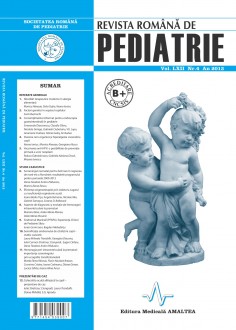SELECT ISSUE

Indexed

| |

|
|
|
| |
|
|
|

|
|
|
|
|
|
|
HIGHLIGHTS
National Awards “Science and Research”
NEW! RJP has announced the annually National Award for "Science and Research" for the best scientific articles published throughout the year in the official journal.
Read the Recommendations for the Conduct, Reporting, Editing, and Publication of Scholarly work in Medical Journals.
The published medical research literature is a global public good. Medical journal editors have a social responsibility to promote global health by publishing, whenever possible, research that furthers health worldwide.
EFICIENTA OXIGENOTERAPIEI PRIN IZOLETA LA SUGARUL CU INSUFICIENTA RESPIRATORIE ACUTA
Ioana Badiu Tisa, Angela Butnariu, Nicolae Miu, Gabriel Samasca and Sorana D. Bolboaca
REZUMAT
Oxigenoterapia este principala metoda de tratament în insuficienţa respiratorie acută la copil. Metoda administrării oxigenoterapiei cu izoleta la sugar reprezintă o metodă frecvent folosită în practica pediatrică.
Obiective. Evaluarea eficacităţii oxigenoterapiei administrate cu izoleta la sugarul cu insuficienţă respiratorie acută de cauză pneumogenă prin compararea a două metode de măsurare a saturaţiei în oxigen a hemoglobinei: din sânge capilar arterializat şi prin pulsoximetrie.
Material şi metodă. Au fost luaţi în studiu 30 de sugari, cu insuficienţă respiratorie acută de cauză pneumogenă. S-a utilizat un scor clinic de apreciere a insuficienţei respiratorii acute, care evaluează frecvenţa respiratorie, bătaia aripioarelor nazale, tiraj, cianoza, senzoriu, înainte şi după oxigenoterapie. Din sângele capilar arterializat s-a mă- surat presiunea parţială a oxigenului şi saturaţia în oxigen a hemoglobinei şi s-a citit cu analizorul Automatic Blood Gas System. Concomitent s-a măsurat şi saturaţia în oxigen a hemoglobinei utilizând puls oximetrul. Măsurătorile au fost efectuate înaintea iniţierii terapiei cu oxigen şi după 30 de minute şi 60 de minute de la iniţierea oxigenoterapiei.
Rezultate. Comparativ cu valorile bazale, înregistrate înaintea iniţierii oxigenoterapiei, s-a înregistrat ameliorarea semnificativă statistic a scorului clinic atât la 30 de minute cât şi la 60 de minute după instituirea terapiei cu oxigen (p < 0,001). Ameliorarea a fost mai amplă la 60 de minute. Presiunea parţială a oxigenului a avut un trend ascendent semnificativ statistic atât la determinarea la 30 de minute cât şi la 60 de minute (p < 0,001). Pentru ambele metode de măsurare ale SaO2 au fost înregistrate creşteri semnificative statistic (p < 0,001) ale acestei variabile după 30 respectiv 60 de minute.
Concluzii. Oxigenoterapia administrată cu izoleta ameliorează insuficienţa respiratorie acută evaluată prin scor clinic. Administrarea oxigenoterapiei cu izoleta la sugar creşte semnificativ valorile presiunii parţiale a oxigenului şi a saturaţiei în oxigen a hemoglobinei măsurată din sânge capilar, precum şi valorile saturaţiei în oxigen a he moglobinei determinate cu pulsoximetrul atât la 30 de minute, cât şi la 60 de minute. Creşterile celor trei parametri sunt mai ample la 60 de minute. Există o concordanţă semnificativă statistic între valorile saturaţiei în oxigen a hemoglobinei determinată din sânge capilar şi prin pulsoximetrie în toate determinările.
Cuvinte cheie: presiunea parţială a oxigenului, parametri Astrup, saturaţia în oxigen a hemoglobinei, pulsoximetria
